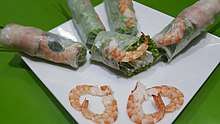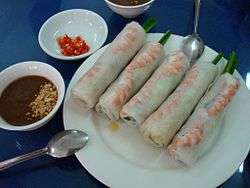Gỏi cuốn
Gỏi cuốn,[1] Vietnamese spring roll, fresh spring roll, spring roll, or rice paper roll,[2][3][4][5][6] is a Vietnamese dish traditionally consisting of pork, prawn, vegetables, bún (rice vermicelli), and other ingredients wrapped in Vietnamese bánh tráng (commonly known as rice paper or cold roll).[7][8] Like other spring roll dishes, they are believed to have an origin in China and were introduced to Vietnam by Chinese immigrants although the gỏi cuốn has been modified to suit local tastes.[9][10]
 Gỏi cuốn wrapped in Vietnamese bánh tráng | |
| Alternative names | Nem cuốn, fresh spring roll, summer roll, salad roll, cold roll, rice paper roll |
|---|---|
| Course | Hors d'oeuvre |
| Place of origin | Vietnam |
| Region or state | Southeast Asia |
| Serving temperature | Room temperature |
| Main ingredients | Pork, prawns, vegetables, bún, and bánh tráng |
Gỏi cuốn are served fresh while others are served fried, like the Vietnamese chả giò.[11] They are served at room temperature (or cooled) and are not deep-fried or cooked on the outside. These rolls are considered to be a very popular appetizer with customers in Vietnamese restaurants.
Preparation


The bánh tráng (rice paper) is dipped in water, then laid flat on a plate with the desired amount of ingredients placed on top. The fresh gỏi cuốn is then rolled up and ready to be eaten. Gỏi cuốn can be served with tương xào (also known as hoisin sauce), which consists of ground tương (tương đen or tương xay) and mixed coconut water (or broth), before being stir-fried with garlic and some sugar and then sprinkled with chili powder and ground peanuts. Alternatively, gỏi cuốn can be served with peanut sauce or other Vietnamese dipping sauces, such as nước chấm, a condiment based on fish sauce.[12]
In Vietnam and in various parts of Southeast Asia, Vietnamese can be seen hand-making bánh tráng (rice paper) and placing them on the rectangular bamboo trays around their houses. Traditionally, gỏi cuốn are eaten with a large group of people at a home setting.[13][14]
Regional
In southern Vietnam, these rolls are called gỏi cuốn, meaning salad rolls, while in northern Vietnam, these rolls are called nem cuốn, meaning nem rolls. In central Vietnam, they are simply called "rice paper" rolls. In the West, these rolls are called by several different English names, including "salad roll", "spring roll" and "summer roll." Sometimes the word "Vietnamese" is added at the beginning of these words; for example, in Hong Kong, they are called "Vietnamese rolls", and in Australia and the United States they may be called "Vietnamese spring rolls" (although specifically in Australia they may sometimes be referred to as "cold rolls"). Some Asian restaurants in the United States also refer to them as "crystal rolls", "soft rolls" or "salad rolls". The name "summer roll" was popularized by some Vietnamese American restaurants for easier marketing and as a seasonal play on the term "spring roll". But many Vietnamese American restaurants still use "spring roll" as the English translation.
Fresh rolls are easily distinguished from similar rolls by the fact that they are not fried, and the ingredients used are different from (deep-fried) Vietnamese egg rolls. In Cambodia, Vietnamese gỏi cuốn are called nime chao, meaning "raw rice paper"; they are produced by a different technique in the Siem Reap and Battambang areas from that in Vietnam. Another dish called kuy tieu kat ("cut rice noodles") is created from steaming the water mixture and adding meat, vegetables and other assorted condiments. In Japan, they are called nama harumaki (生春巻き, "raw spring rolls"), and are typically filled with shrimp.
Variants
The fillings can vary from the standard pork slices, pork sausage slices (chả), and shrimp; fish, pan-fried seafood (such as squid), beef poached in a lemongrass broth, tofu (for vegetarians), grilled nem nướng sausages, braised pork, and egg are among some of the other popular spring roll variations.
See also
References
- Thaker, Aruna; Barton, Arlene, eds. (2012). Multicultural Handbook of Food, Nutrition and Dietetics. Wiley-Blackwell. p. 171.
- Spring roll showdown in Little Saigon, Orange County Register (archived from the original on 2011-11-26).
- Helen, Clark; Miller, Karryn (2017-07-12). "40 delicious Vietnamese dishes". CNN Travel.
- "Vietnamese Spring Rolls Recipe". O'Yumm Recipes.
- "Brodard Chateau - Vietnamese Cuisine - Garden Grove". www.brodard.net.
- "Vietnamese spring rolls at Saigon Bistro, 6244 N. California Ave". ABC7 Chicago. 2012-04-21.
- Nguyen, Andrea. Into the Vietnamese Kitchen: Treasured Foodways, Modern Flavors. p. 32.
- Le, Ann. The Little Saigon Cookbook: Vietnamese Cuisine and Culture in Southern California's Little Saigon. p. 56.
- Beyond Egg Rolls: 9 Spring Rolls Everyone Should Know About, Thrillist
- VIETNAM: Gỏi Cuốn Vietnamese Spring Rolls are Fresh! (Recipe), Will Fly For Food
- "Vietnamese Spring Rolls - A Taste for Any Season". Vietnam Talking Points. 2010-07-16. Archived from the original on 2016-03-03. Retrieved 2016-02-16.
- Herman, Michael (2012-03-25). "Vietnamese Summer Rolls - Gỏi Cuốn". New York Food Journal.
- Clements, Miles (2010-10-07). "The Find: Dat Thanh in Westminster". Los Angeles Times.
- Jacobson, Max (1997-09-25). "A Real Meal for Under $4? It's True". Los Angeles Times.
External links
| Wikimedia Commons has media related to gỏi cuốn. |
| Wikibooks Cookbook has a recipe/module on |